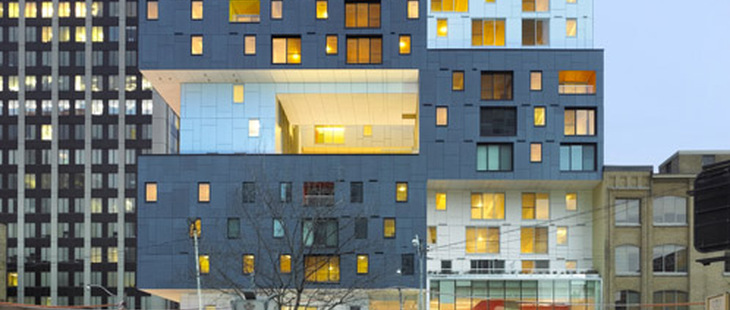

Toronto Community Housing Corporation has had a good decade, and a very bad year.
Before last year, the city agency was most famous for its groundbreaking redevelopment of Regent Park — which is, so far, looking very wise in its mix of public housing and private developments. The new buildings look good, and the condos have sold fast and pricily. People are paying half a million dollars for homes at what used to be Toronto’s least desirable address.
But in just six months, the agency has suffered twin shocks: a September fire in a St. Jamestown tower that displaced hundreds of people and raised cries of neglect; and the February leak of a harsh report by the city’s auditor, Jeffrey Griffiths, that Mayor Rob Ford used to dislodge the agency, board, CEO, and former CEO from their city posts.
The details of Griffith’s accusations are still not clear. But the implications are: TCHC’s name is tarred with accusations about corruption and waste. This has serious implications, since the agency is huge — Canada’s biggest landlord, and also one of Toronto’s most active developers, currently planning hundreds of millions of dollars worth of new buildings and renovations. Just imagine what’s hiding in the balance sheets of those projects.
Would you believe: a good news story about a risk-taking, tightly run organization?
In fact, the agency’s developments look like examples for the rest of the city to follow. The new buildings at Regent Park and nearby, in eastern downtown, are extraordinarily well-designed; they’re positioned to bring life back to some dark blocks of downtown; and they’re leaders in green technology. Oh, and they’re cheap, and have come in at or under budget.
It’s a story that deserves to be heard, before new leadership pushes the agency into panic mode and starts to undo its considerable accomplishments.
To start, take 60 Richmond East. Designed by Teeple Architects, one of the city’s most distinguished studios, it may be Toronto’s best residential building of the past decade. TCHC makes a point of demanding excellent design and hiring top talent, and the aesthetic payoff is clear here. It looks like a slightly precarious pile of Jenga, daubed with hot orange and acid yellow splashes.
But there’s nothing self-important about the design. Built as replacement housing for tenants who’ve been displaced from Regent Park, it has 85 large apartments, wrapped around a 10-storey atrium that will feature a community garden and “living wall.” They are remarkably well-planned, well-lit, and in many cases spread over two floors. Plus, the building earned a Gold rating from the LEED environmental certification program. It’s got extremely high levels of insulation, top-quality windows and carefully modulated access to sunlight.
And it came in at under $20-millon, or $185 of budget for each square foot of space. This is a price that’s in line with private-sector condos, which typically have none of the complex structure that makes it so pleasant to be in and to walk past. “When we build we’re spending the same money as the private sector developers but in different ways,” Lizette Zuniga, TCHC’s head of Development and Real Estate, says. Altus, the development industry’s cost consultants of choice, set typical costs at $170 to $200 per square foot. “We’re right there, or even below that on some projects.”
The agency says green features add about seven to ten per cent to its building costs, but they cut energy costs substantially. All of TCHC’s new buildings come in at 25 to 50 percent less energy than building codes demand. “We’ve been trying to operate as a prudent asset manager,” its new Chief Development officer, Bronwyn Krog, says. “For rental buildings, we are a long-term landlord, and we think in those terms.”
There’s no unnecessary luxury in these new homes. Community housing tenants don’t get glass-tile backsplashes and Corian countertops; the apartments are built with cheap and durable finishes. They’re built to last. But they enjoy the advantages of views, light and space that are ultimately more important.
There has been no whiff of scandal around the agency’s purchasing and procurement for construction. All new projects are opened up to public bids, and general contractors likewise have to open up their tenders — for the trades, from foundations to drywall – in accordance with city policy. Other cities have seen such efforts turn into rich veins of graft for politically connected construction companies and trades. Here, no one has even hinted about such wrongdoing at TCHC.
And their buildings are designed with an eye to the public realm and the city around them. Another new project, at 501 Adelaide Street East, has 180 apartments housing about 600 people. On its north side it faces the roaring traffic of Adelaide with a handsome, transparent facade. And on its other end, facing the furniture row of King East, it’s got a beautifully built, two-storey retail space that houses one of the city’s toniest furniture shops, Kiosk. Its kids are playing in the splash pad in summer, biking down streets that have been child-free for decades – and filling out classrooms in downtown schools that have lots of space for them.
The building was actually born as a condo, designed by the award-winning firm architectsAlliance and built by Context Development. But just before the developer started to sell the project, TCHC called up Context head Howard Cohen to make a deal.
“I was really impressed by how businesslike they were,” says Cohen, who has been a Toronto city planner, the head of Harbourfront Corp. and head of the Design Exchange. “They went about negotiations in a businesslike way. They were fair. They knew what they wanted. And we made a deal both parties were satisfied with.”
In the end, Cohen’s construction management company built the tower, in modified form to accommodate TCHC tenants. “We were able to produce a really good building,” Cohen says, “and it came in under budget.”
This sort of partnership with the private sector allows the agency to maintain a leaner operation, and to leverage the machines of experienced developers like Context – and Daniels Corp., who are rebuilding much of Regent Park while developing their own for-profit buildings – toward good and cost-effective construction. “They are channelling the private sector, and they’re getting better prices that way,” Cohen says. “I know, because with the price we’re giving them, they could never match by doing it themselves. I have an organization in place.”
This nimble, small-government approach sounds like the sort of things that Rob Ford is advocating across the city’s government. And yet the driving force for these projects was former CEO Derek Ballantyne. His successor, Keiko Nakamura, was likewise closely aligned with the ambitious plans for Regent Park and with their execution. Now they’ve both been unceremoniously bounced, Ballantyne from his new position at the city agency Build Toronto. This raises an obvious question: can the agency sustain its momentum and its quality? And will it?
Cohen, who has seen more than a few municipal leaders come and go, is deeply concerned. “I fear, as a Torontonian, that all of the entrepreneurship at TCHC has been driven into the ground,” he says. “No one is going to stick their neck out now. They’ll all feel like they have an auditor looking over their shoulder — and auditors don’t look at things in a businesslike way; they think about procedure. If you do something that saves money but you don’t follow the rules, that’s it.”
What does this mean? An example. Cohen’s company Context had the winning bid for another large TCHC project; at 150 Fort York Blvd., it’s part of the Cityplace neighbourhood near Front and Bathurst. The architects are KPMB, one of the country’s best firms. And the team came up with a way to improve the design: pushing apartments from towers into townhouses. “We thought, if you’re a mother with three kids, it’s a huge advantage to not have an elevator and a corridor,” Cohen says. And with no elevator or corridor to build, this cuts costs. “They’re bigger than the usual units, and they cost less money.”
But that raised the ire of some TCHC administrators. “Someone at TCHC said, ‘These are too big!'” Not because of higher maintenance costs, but simply because “they didn’t fit the formula,” Cohen says. “If that way of thinking had prevailed, the whole project would have fallen apart. But it didn’t, this time.”
Other people who have done business with the agency generally speak highly of its practices. But one architect who has worked with TCHC says he dealt with a project manager who was too rule-bound, and “a split culture” in which maintenance staff push for unnecessarily expensive and arduous details. “They’re not entrepreneurs,” the architect says. “They don’t move expeditiously to capture savings. They have their rules, and sometimes they’re painted into a corner with their rules.”
And the solution? “They need leadership that can push to get things done,” says the architect.
Krog — veteran of several private-sector development companies – is well regarded in the industry. And she says the agency’s redevelopment plans are full speed ahead. But is the political will there to allow TCHC to continue to wheel and deal? Cohen says he sees signs of hesitation and T-crossing in his dealings with the agency these days. “I’m afraid that a fearful, bureaucratic mentality is going to take over, and as a citizen, that infuriates me.”
Surely Mayor Ford doesn’t want to be the guy who let the bureaucrats win.














